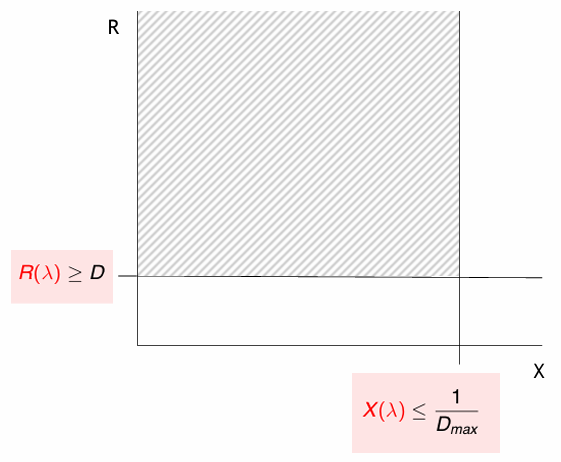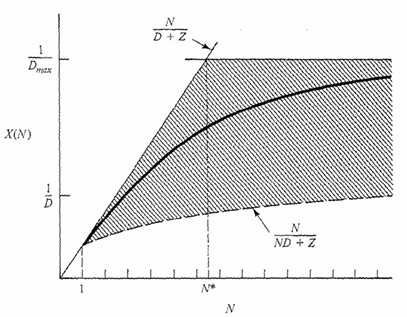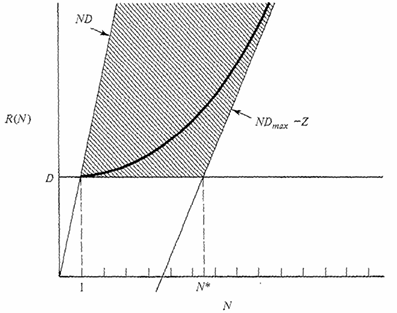Performance bounds provide valuable insight into the primary factors affecting the performance of computer systems. They can be computed quickly and easily, therefore serving as a first-cut modeling technique. Several alternatives can be treated together. We will consider single-class systems only and determine asymptotic bounds, i.e., upper and lower bounds on a system’s performance indices
The advantages of bounding analysis are that they highlight and quantify the critical influence of the system bottleneck. The can be computed quickly, even by hand, and are useful in system sizing based on preliminary estimates. This kind of studies typically involve a large number of candidate configurations with a single critical resource (e.g., CPU) dominant and the other configured accordingly, treated as one alternative. They are also useful for system upgrades.
Bottleneck
Definition
The bottleneck is the resource within a system that has the greatest service demand. Its service demand is
, denoted .
The bottleneck resource is important, because it limits the possible performance of the system. This will be the resource that has the highest utilization in the system.
Notation
The considered models and the bounding analysis make use of the following parameters:
, the number of service centers , the sum of the service demands at the centers, so , the largest service demand at any single center , the average think time, which represents the time spent by a user thinking or performing other non-computational tasks while waiting for a response in interactive systems
These parameters are important in determining the performance of computer systems. The performance quantities that are considered in the analysis are:
, the system throughput, which represents the number of jobs completed per unit of time , the system response time, which represents the time taken for a job to complete from the moment it enters the system until it receives a response
By analyzing these parameters and performance quantities, we can derive bounds on the system’s performance under different conditions, such as light load and heavy load. These bounds provide valuable insights into the system’s behavior and help in system sizing and performance estimation.
Asymptotic bounds
The bounding analysis is based on the assumption that the service demand of a customer at a center does not depend on how many other customers currently are in the system or at which service centers they are located. This allows us to derive asymptotic bounds that provide upper and lower limits on the system's performance indices
and .
Asymptotic bounds are derived by considering the (asymptotically) extreme conditions of light and heavy loads. We can derive both optimistic and pessimistic bounds on the system’s performance indices
- Optimistic:
upper bound and lower bound. The optimistic bounds correspond to the best-case scenario, where the system performs at its maximum capacity - Pessimistic:
lower bound and upper bound. The pessimistic bounds correspond to the worst-case scenario, where the system is overloaded and performance is severely degraded
Open models
The
The
The
- If no customers interfere with any other, then
, with - If
customers arrive together every time units, there is no pessimistic bound on . Customers at the end of the batch are forced to queue for customers at the front of the batch, and thus experience large response times. The batch can be extremely long, , and there is no pessimistic bound on response times, regardless of how small the arrival rate might be.

| Bound for | Bound for |
|---|---|
Closed models
The
Light Load situation (lower bounds): in the light load situation, the system is not saturated, and the smallest possible
Then
Adding customers, the smallest
Largest
Heavy Load situation (upper bound): in the heavy load situation, the system is saturated, and the largest possible
Since the first to saturate is the bottleneck,
Formulas
So, the
bounds are

We can define a particular population size
Let us simply rewrite the previous equation, considering that
and to have
Formula
The
bounds are

| Bound for | Bound for |
|---|---|